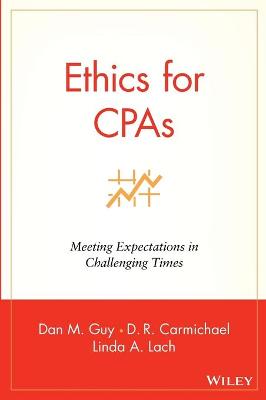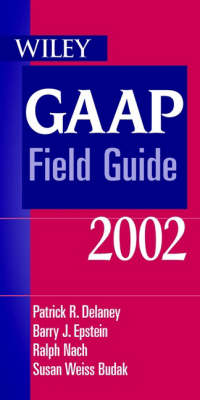Ethics for CPAs
 -15%
portes grátis
-15%
portes grátis
Ethics for CPAs
Meeting Expectations in Challenging Times
Guy, Dan M.; Lach, Linda A.; Carmichael, D. R.
John Wiley & Sons Inc
01/2003
400
Dura
Inglês
9780471271765
15 a 20 dias
882
Descrição não disponível.
PART A. INTRODUCTION TO ETHICS. Chapter 1. Introduction.
Chapter 2. Organizations Involved in the Development, Regulation, and Enforcement of Ethics Requirements.
Chapter 3. Ethics Enforcement-What a Member Needs to Know.
PART B. OVERVIEW OF INDEPENDENCE, INTEGRITY, AND OBJECTIVITY.
Chapter 4. The Fall of Enron and the Ethics Aftermath.
Chapter 5. Importance of Independence.
Chapter 6. Basic Concepts of Rule 101, Independence, and Rule 102, Integrity and Objectivity.
Chapter 7. Requirements for Integrity and Objectivity (Including Freedom from Conflicts of Interest).
PART C. INDEPENDENCE REQUIREMENTS FOR MEMBERS IN PUBLIC PRACTICE.
Chapter 8. Engagements That Require Independence.
Chapter 9. Definition of Covered Member/Person, Immediate Family Members, and CPA Firms for Purposes of Independence Requirements.
Chapter 10. Direct and Indirect Financial Interests in Clients.
Chapter 11. Financial Interests in Nonclients That Have Investor or Investee Relationships with Clients.
Chapter 12. Former Practitioners.
Chapter 13. Unpaid Fees.
Chapter 14. Performance of Other Services for Clients.
Chapter 15. Business Relationships; Cooperative Arrangements; Joint Closely Held Investments; Lease Arrangements; and Investments by Clients in Auditors.
Chapter 16. Loans to and from Clients.
Chapter 17. Employment by and Connections with Clients.
Chapter 18. Employment of a Spouse, Dependent, or Close Relative by a Client.
Chapter 19. Gifts and Privileges.
Chapter 20. Actual or Threatened Litigation.
Chapter 21. Indemnification Agreements.
Chapter 22. Outsourcing of the Internal Audit Function and Other Extended Audit Services.
Chapter 23. Independence Requirements for Governmental Audits and Nonprofit Organizations Subject to Yellow Book Requirements.
Chapter 24. Independence Requirements for Audits of Employee Benefit Plans.
Chapter 25. Independence Requirements for Agreed-Upon Procedures Engagements.
Chapter 26. Alternative Practice Structures.
Chapter 27. Quality Control Systems for Independence.
PART D. AICPA RULES OTHER THAN INDEPENDENCE, INTEGRITY, AND OBJECTIVITY.
Chapter 28. Rules 201, 202, and 203-General Standards, Compliance with Standards and Accounting Principles.
Chapter 29. Rule 301-Confidential Client Information.
Chapter 30. Rule 302-Contingent Fees.
Chapter 31. Rule 501-Acts Discreditable.
Chapter 32. Rule 502-Advertising and Other Forms of Solicitation.
Chapter 33. Rule 503-Commissions and Referral Fees.
Chapter 34. Rule 505-Form of Organization and Name.
PART E. OTHER ETHICS GUIDANCE.
Chapter 35. Statements on Standards for Tax Services and Interpretations.
Chapter 36. Statements on Standards for Consulting Services.
Chapter 37. An Interpretative Outline of IFAC's Code of Ethics for Professional Accountants.
Chapter 38. Where to Go for More Information.
Appendix A. Glossary.
Appendix B. How to Contact the State Boards and State Societies.
2003 Self-Study CPE Program.
Index.
Chapter 2. Organizations Involved in the Development, Regulation, and Enforcement of Ethics Requirements.
Chapter 3. Ethics Enforcement-What a Member Needs to Know.
PART B. OVERVIEW OF INDEPENDENCE, INTEGRITY, AND OBJECTIVITY.
Chapter 4. The Fall of Enron and the Ethics Aftermath.
Chapter 5. Importance of Independence.
Chapter 6. Basic Concepts of Rule 101, Independence, and Rule 102, Integrity and Objectivity.
Chapter 7. Requirements for Integrity and Objectivity (Including Freedom from Conflicts of Interest).
PART C. INDEPENDENCE REQUIREMENTS FOR MEMBERS IN PUBLIC PRACTICE.
Chapter 8. Engagements That Require Independence.
Chapter 9. Definition of Covered Member/Person, Immediate Family Members, and CPA Firms for Purposes of Independence Requirements.
Chapter 10. Direct and Indirect Financial Interests in Clients.
Chapter 11. Financial Interests in Nonclients That Have Investor or Investee Relationships with Clients.
Chapter 12. Former Practitioners.
Chapter 13. Unpaid Fees.
Chapter 14. Performance of Other Services for Clients.
Chapter 15. Business Relationships; Cooperative Arrangements; Joint Closely Held Investments; Lease Arrangements; and Investments by Clients in Auditors.
Chapter 16. Loans to and from Clients.
Chapter 17. Employment by and Connections with Clients.
Chapter 18. Employment of a Spouse, Dependent, or Close Relative by a Client.
Chapter 19. Gifts and Privileges.
Chapter 20. Actual or Threatened Litigation.
Chapter 21. Indemnification Agreements.
Chapter 22. Outsourcing of the Internal Audit Function and Other Extended Audit Services.
Chapter 23. Independence Requirements for Governmental Audits and Nonprofit Organizations Subject to Yellow Book Requirements.
Chapter 24. Independence Requirements for Audits of Employee Benefit Plans.
Chapter 25. Independence Requirements for Agreed-Upon Procedures Engagements.
Chapter 26. Alternative Practice Structures.
Chapter 27. Quality Control Systems for Independence.
PART D. AICPA RULES OTHER THAN INDEPENDENCE, INTEGRITY, AND OBJECTIVITY.
Chapter 28. Rules 201, 202, and 203-General Standards, Compliance with Standards and Accounting Principles.
Chapter 29. Rule 301-Confidential Client Information.
Chapter 30. Rule 302-Contingent Fees.
Chapter 31. Rule 501-Acts Discreditable.
Chapter 32. Rule 502-Advertising and Other Forms of Solicitation.
Chapter 33. Rule 503-Commissions and Referral Fees.
Chapter 34. Rule 505-Form of Organization and Name.
PART E. OTHER ETHICS GUIDANCE.
Chapter 35. Statements on Standards for Tax Services and Interpretations.
Chapter 36. Statements on Standards for Consulting Services.
Chapter 37. An Interpretative Outline of IFAC's Code of Ethics for Professional Accountants.
Chapter 38. Where to Go for More Information.
Appendix A. Glossary.
Appendix B. How to Contact the State Boards and State Societies.
2003 Self-Study CPE Program.
Index.
Este título pertence ao(s) assunto(s) indicados(s). Para ver outros títulos clique no assunto desejado.
misdeeds; handful; accounting; regulations; enron; ethical; highprofile; profession; flurry; entire; new; cpas; map; ethics; new landscape; accounting professionals; instructing; pronouncements; necessary; professionally respond
PART A. INTRODUCTION TO ETHICS. Chapter 1. Introduction.
Chapter 2. Organizations Involved in the Development, Regulation, and Enforcement of Ethics Requirements.
Chapter 3. Ethics Enforcement-What a Member Needs to Know.
PART B. OVERVIEW OF INDEPENDENCE, INTEGRITY, AND OBJECTIVITY.
Chapter 4. The Fall of Enron and the Ethics Aftermath.
Chapter 5. Importance of Independence.
Chapter 6. Basic Concepts of Rule 101, Independence, and Rule 102, Integrity and Objectivity.
Chapter 7. Requirements for Integrity and Objectivity (Including Freedom from Conflicts of Interest).
PART C. INDEPENDENCE REQUIREMENTS FOR MEMBERS IN PUBLIC PRACTICE.
Chapter 8. Engagements That Require Independence.
Chapter 9. Definition of Covered Member/Person, Immediate Family Members, and CPA Firms for Purposes of Independence Requirements.
Chapter 10. Direct and Indirect Financial Interests in Clients.
Chapter 11. Financial Interests in Nonclients That Have Investor or Investee Relationships with Clients.
Chapter 12. Former Practitioners.
Chapter 13. Unpaid Fees.
Chapter 14. Performance of Other Services for Clients.
Chapter 15. Business Relationships; Cooperative Arrangements; Joint Closely Held Investments; Lease Arrangements; and Investments by Clients in Auditors.
Chapter 16. Loans to and from Clients.
Chapter 17. Employment by and Connections with Clients.
Chapter 18. Employment of a Spouse, Dependent, or Close Relative by a Client.
Chapter 19. Gifts and Privileges.
Chapter 20. Actual or Threatened Litigation.
Chapter 21. Indemnification Agreements.
Chapter 22. Outsourcing of the Internal Audit Function and Other Extended Audit Services.
Chapter 23. Independence Requirements for Governmental Audits and Nonprofit Organizations Subject to Yellow Book Requirements.
Chapter 24. Independence Requirements for Audits of Employee Benefit Plans.
Chapter 25. Independence Requirements for Agreed-Upon Procedures Engagements.
Chapter 26. Alternative Practice Structures.
Chapter 27. Quality Control Systems for Independence.
PART D. AICPA RULES OTHER THAN INDEPENDENCE, INTEGRITY, AND OBJECTIVITY.
Chapter 28. Rules 201, 202, and 203-General Standards, Compliance with Standards and Accounting Principles.
Chapter 29. Rule 301-Confidential Client Information.
Chapter 30. Rule 302-Contingent Fees.
Chapter 31. Rule 501-Acts Discreditable.
Chapter 32. Rule 502-Advertising and Other Forms of Solicitation.
Chapter 33. Rule 503-Commissions and Referral Fees.
Chapter 34. Rule 505-Form of Organization and Name.
PART E. OTHER ETHICS GUIDANCE.
Chapter 35. Statements on Standards for Tax Services and Interpretations.
Chapter 36. Statements on Standards for Consulting Services.
Chapter 37. An Interpretative Outline of IFAC's Code of Ethics for Professional Accountants.
Chapter 38. Where to Go for More Information.
Appendix A. Glossary.
Appendix B. How to Contact the State Boards and State Societies.
2003 Self-Study CPE Program.
Index.
Chapter 2. Organizations Involved in the Development, Regulation, and Enforcement of Ethics Requirements.
Chapter 3. Ethics Enforcement-What a Member Needs to Know.
PART B. OVERVIEW OF INDEPENDENCE, INTEGRITY, AND OBJECTIVITY.
Chapter 4. The Fall of Enron and the Ethics Aftermath.
Chapter 5. Importance of Independence.
Chapter 6. Basic Concepts of Rule 101, Independence, and Rule 102, Integrity and Objectivity.
Chapter 7. Requirements for Integrity and Objectivity (Including Freedom from Conflicts of Interest).
PART C. INDEPENDENCE REQUIREMENTS FOR MEMBERS IN PUBLIC PRACTICE.
Chapter 8. Engagements That Require Independence.
Chapter 9. Definition of Covered Member/Person, Immediate Family Members, and CPA Firms for Purposes of Independence Requirements.
Chapter 10. Direct and Indirect Financial Interests in Clients.
Chapter 11. Financial Interests in Nonclients That Have Investor or Investee Relationships with Clients.
Chapter 12. Former Practitioners.
Chapter 13. Unpaid Fees.
Chapter 14. Performance of Other Services for Clients.
Chapter 15. Business Relationships; Cooperative Arrangements; Joint Closely Held Investments; Lease Arrangements; and Investments by Clients in Auditors.
Chapter 16. Loans to and from Clients.
Chapter 17. Employment by and Connections with Clients.
Chapter 18. Employment of a Spouse, Dependent, or Close Relative by a Client.
Chapter 19. Gifts and Privileges.
Chapter 20. Actual or Threatened Litigation.
Chapter 21. Indemnification Agreements.
Chapter 22. Outsourcing of the Internal Audit Function and Other Extended Audit Services.
Chapter 23. Independence Requirements for Governmental Audits and Nonprofit Organizations Subject to Yellow Book Requirements.
Chapter 24. Independence Requirements for Audits of Employee Benefit Plans.
Chapter 25. Independence Requirements for Agreed-Upon Procedures Engagements.
Chapter 26. Alternative Practice Structures.
Chapter 27. Quality Control Systems for Independence.
PART D. AICPA RULES OTHER THAN INDEPENDENCE, INTEGRITY, AND OBJECTIVITY.
Chapter 28. Rules 201, 202, and 203-General Standards, Compliance with Standards and Accounting Principles.
Chapter 29. Rule 301-Confidential Client Information.
Chapter 30. Rule 302-Contingent Fees.
Chapter 31. Rule 501-Acts Discreditable.
Chapter 32. Rule 502-Advertising and Other Forms of Solicitation.
Chapter 33. Rule 503-Commissions and Referral Fees.
Chapter 34. Rule 505-Form of Organization and Name.
PART E. OTHER ETHICS GUIDANCE.
Chapter 35. Statements on Standards for Tax Services and Interpretations.
Chapter 36. Statements on Standards for Consulting Services.
Chapter 37. An Interpretative Outline of IFAC's Code of Ethics for Professional Accountants.
Chapter 38. Where to Go for More Information.
Appendix A. Glossary.
Appendix B. How to Contact the State Boards and State Societies.
2003 Self-Study CPE Program.
Index.
Este título pertence ao(s) assunto(s) indicados(s). Para ver outros títulos clique no assunto desejado.





